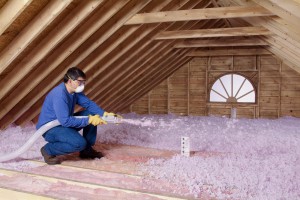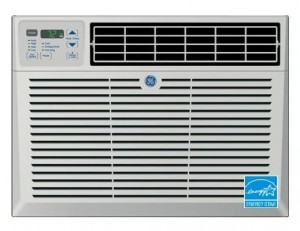Feeling Good About Air Conditioning Your Home During The Summer

Have you ever been told that your car uses more gasoline and reduces the mileage when you run the air conditioner during the summer months? Similarly, the same question applies to homeowners who question the use of electricity used for air conditioning vs. the fuels used to heat their homes during the summer months. Specialists in Home Performance and Home Energy Efficiency at Alure Home Improvements are always ready to help people understand what they can do to make their homes greener.
Generally speaking, appliance use in any home averages 18% of the total energy consumption. Refrigerators are the largest energy draw with heating and air conditioning a close second. However when using Energy Star Appliances, they comparably reduce energy consumption anywhere from 10%-15%. This can reduce your home’s carbon footprint making you a better friend to the environment. If one in every ten households in America used all Energy Star appliances it would equal the benefit to the environment of planting 1.7 million acres of trees. If every room air conditioner sold had earned the Energy Star rating, it would prevent 900 million pounds of greenhouse gas emissions annually, equivalent to the emissions from 80,000 cars.
Home improvement projects that help create energy savings aren’t just about the fuel bill but also comfort. Making sure the air conditioner is correct for your size room is only one of the many ways to make your home more comfortable and green. Adding attic insulation, installing new siding or windows and investigating even newer technology like air sealing all have the potential to satisfy a desire to be more environmentally conscious.
 An unheated crawlspace can send cold air up through the floor of your home, making your heating and cooling system work harder and waste energy. Adding insulation between the joists in the crawlspace ceiling can keep the rooms above more comfortable and lower your energy bills. When you think Attic Insulation: Pink is the New Green! The Owens Corning Pink insulation installed by Alure not only saves energy, but it also helps conserve natural resources by using widely available and plentiful resources – sand and recycled glass.
An unheated crawlspace can send cold air up through the floor of your home, making your heating and cooling system work harder and waste energy. Adding insulation between the joists in the crawlspace ceiling can keep the rooms above more comfortable and lower your energy bills. When you think Attic Insulation: Pink is the New Green! The Owens Corning Pink insulation installed by Alure not only saves energy, but it also helps conserve natural resources by using widely available and plentiful resources – sand and recycled glass.
When looking for window mounted air conditioners for this summer’s cooling season, be sure to explore the actual need for your household. The BTU ratings are clearly listed on the box of most air conditioner products that you will find at most major appliance stores. They will explain the average requirements in BTU’s (British thermal unit) for the different sizes of rooms in most homes. Too few BTU’s and the air conditioning unit will run too long and too often. This will negate what savings you may have hoped to create by purchasing an Energy Star rated appliance. Too many BTU’s for your space is a larger draw on your electric service than necessary.
 In addition to size, consider an air conditioner’s EER – energy efficiency ratio. The EER approximates the unit’s operating cost as compared to similar models. The Higher the EER number, the less it will cost you to operate. The Association of Home Appliance Manufacturers reports that the average EER of room air conditioners rose 47% from 1972 to 1991. If you own a 1970’s-vintage room air conditioner with an EER of 5 and you replace it with a new one with an EER of 10, you will cut your air conditioning energy costs in half.
In addition to size, consider an air conditioner’s EER – energy efficiency ratio. The EER approximates the unit’s operating cost as compared to similar models. The Higher the EER number, the less it will cost you to operate. The Association of Home Appliance Manufacturers reports that the average EER of room air conditioners rose 47% from 1972 to 1991. If you own a 1970’s-vintage room air conditioner with an EER of 5 and you replace it with a new one with an EER of 10, you will cut your air conditioning energy costs in half.
Homeowner Cost Saver Tips:
-
Setting your air conditioner’s thermostat as high as is comfortably possible in the summer reduces the difference between the indoor and outdoor temperatures. Your air conditioning units will not have to work as hard and the lower your overall cooling bill will be. Although it seems to make sense, don’t set your thermostat at a colder setting than normal when you first turn your unit on; it will not cool your home any faster. It will make the air conditioner work harder and it will cycle more often. The subsequent result is excessive cooling and unnecessary expense.
-
It is usually less expensive to cool only the rooms you are using most in the summer months than to air condition the whole house. Window air conditioning units are a technology that has come a long way in recent years. Using energy star rated products provide plenty of incentive to upgrade your appliances, reduce your energy consumption and increase your comfort during a long hot summer.
Choosing the right size when shopping for a room air conditioner is extremely important. Units that are bigger than necessary may not be able to remove the humidity effectively, resulting in an uncomfortable room. A quick and easy way to determine the right size is to refer to the chart below.
| Area To Be Cooled (square foot) | Capacity Needed (BTU/Hour) |
| 100 to 150 | 5,000 |
| 150 to 250 | 6,000 |
| 250 to 300 | 7,000 |
| 300 to 350 | 8,000 |
| 350 to 400 | 9,000 |
| 400 to 450 | 10,000 |
| 450 to 550 | 12,000 |
| 550 to 700 | 14,000 |
| 700 to 1000 | 18,000 |
| 1,000 to 1,200 | 21,000 |
| 1,200 to 1,400 | 23,000 |
| 1,400 to 1,500 | 24,000 |
| 1,500 to 2,000 | 30,000 |
Make adjustments for the following circumstances:
-
If the room is heavily shaded, reduce capacity by 10%.
-
If the room is very sunny, increase capacity by 10%.
-
If more than two people regularly occupy the room, add 600 BTUs for each additional person.
-
If the unit is used in a kitchen, increase capacity by 4,000 BTUs.
-
Consider where you install the unit. If you are mounting an air conditioner near the corner of a room, look for a unit that can send the airflow in the right direction.
-
For the purpose of this chart, rooms that are connected by permanently open entryways wider than five feet ought to be considered as one room and their square footage should be combined.
Share some of your summer secrets for keeping cool.
To find out more information about air conditioners and other appliances click here.
- Additions and New Construction
- All Exteriors
- Alterations
- Basements
- Bathrooms
- Customer Service
- Customer Stories
- Decks
- Design & Planning Show
- DIY
- Doors
- Educational Resources
- Extreme Makeover Home Edition
- Fashion Show
- General Remodeling
- Green Living
- Handyman Home Services
- Home Decor
- Home Entertainment
- Home Improvement
- Home Improvements
- How to Tips
- In The Community
- Kitchens
- Off-the-Wall Remodeling Stories
- Remodeling
- Resources
- Roofing
- Siding
- Social Media
- Sunrooms
- Tips & Tricks
- Trends
- Windows

